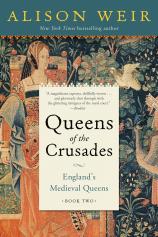Queens of the Crusades: England's Medieval Queens Book Two
Review
Queens of the Crusades: England's Medieval Queens Book Two
If there was such a profession as forensic time-traveling trip advisor, British author Alison Weir would qualify, and then some.
QUEENS OF THE CRUSADES, her latest in an impressive canon of more than two-dozen historical biographies and novels, tracks medieval journeys with an extraordinary precision worthy of 21st-century royal itineraries. Days, months, years, routes, retinues, lodgings, weather conditions, luggage, expenditures, catastrophes --- all some nine centuries in the past --- leap from Weir’s pages amid the turbulent politics and culture of 12th- and 13th-century post-Norman Conquest society.
Simply put, European rulers of widely dispersed subjects were almost obliged to be constantly on the move, since in-person engagement was the only sure means of verifying one’s existence and presenting a visibly powerful image to supporters and rivals.
Back then, the borders of England and France were fluid, to put it mildly. During the fractious period spanned by the reigns of Henry II, Richard I, John I, Henry III, Edward I and their remarkable consorts, all queens in their own right, the distinct countries we know today were uneasily twinned across the Channel as a bickering, contentious empire of semi-autonomous regions and states.
"In its abundant detail about real lives lived amid the broad political strokes of medieval kings, QUEENS OF THE CRUSADES captures a rich sensory impression of how five brilliant yet fallible women managed their subject societies in a precarious and dangerously changeable world."
While these kings officially held all the power, they proved inconsistent and sometimes indecisive in its application, often leaving their responsibilities for years at a stretch to go on papal crusades against little-known but greatly feared “infidels” in the Holy Land. Their queen-consorts, who occasionally accompanied them but mainly held fragile realms together in their absence, were another story, as Weir so powerfully conveys.
QUEENS OF THE CRUSADES is a brilliant, compelling and meticulously detailed revelation of the overlapping lives led by Eleanor of Aquitaine (1122-1204), wife of Henry II; Berengaria of Navarre (1165-1230), wife of Richard I; Isabella of Angoulême (c.1186-1246), wife of John I; Alienor of Provence (c.1223-1291), wife of Henry III; and Eleonore of Castile (1241-1290), wife of Edward I.
Statistically alone, all five women lived far beyond average “old age” of the era. Even Eleonore of Castile, dying just short of 50 and having birthed at least 18 children, would have been a medieval senior citizen by 40. At the other end of the spectrum, the indomitable Eleanor of Aquitaine lived to the extraordinary age of 82, a tireless traveler and administrator until her final year. Not surprisingly, most outlived their older (or more reckless) husbands, becoming powerful even behind the scenes as regents, deal makers, marriage brokers, fundraisers, administrators and, of course, fashion icons.
Through deep research into what medieval royalty bought, ate and wore, Weir turns ancient lists, ledgers, invoices, receipts and personal letters into vivid slices of life at a time when rich and poor alike were equally vulnerable to diseases that baffled medical knowledge. In all of QUEENS OF THE CRUSADES, a single book in the possession of one of Weir’s royal heroines dealt with health and hygiene. That small but important piece of evidence attests to the proactive stance that all five women took when it came to quality-of-life issues.
Because travel was limited to the three basic modes of foot, horse or boat, it entailed elaborate and extensive preparations. Throughout the 12th and 13th centuries, royals on both sides of the Channel didn’t just go on single-suitcase visiting tours. They moved entire households of furniture and personal effects from one castle to another using huge fleets of ships or wagon convoys.
There was no guarantee that the castle left empty for a season wouldn’t have been conquered and taken over by an upstart baron or two before one could return, so it was not unusual for seats of government to move frequently. What never fails to astonish history lovers today is how often and how far people did travel, not just within the land masses of early France and England, but back and forth across the unpredictable English Channel.
Travel may well have influenced royal parenting as well. It was rare for preteen children to travel with their parents, even for arranged political marriages. Infant betrothals, in which all five queens were masterful negotiators, were typically followed by proxy marriages until couples were old enough to meet in person.
And with royal parents seemingly always on crusade or touring the country in the interests of political stability, children were placed very early in the care of nurses and surrogate families of high-ranking loyal nobility. As father and son respectively, Henry II and III barely knew one another and competed for power; it wasn’t unusual for siblings or close cousins from both sides of the water to end up at war.
As Weir illustrates with copious references to correspondence and contemporary chroniclers, it was left to the queens to influence and foster strong personal relationships among themselves and their families throughout long overlapping reigns. Records of lavish gifts in clothing or jewelry, loans, interventions, protection and any number of favors were usually enough to keep channels of communication open even during the worst of times.
In its abundant detail about real lives lived amid the broad political strokes of medieval kings, QUEENS OF THE CRUSADES captures a rich sensory impression of how five brilliant yet fallible women managed their subject societies in a precarious and dangerously changeable world.
Reviewed by Pauline Finch on April 2, 2021
Queens of the Crusades: England's Medieval Queens Book Two
- Publication Date: November 2, 2021
- Genres: History, Nonfiction
- Paperback: 576 pages
- Publisher: Ballantine Books
- ISBN-10: 1101966718
- ISBN-13: 9781101966716




